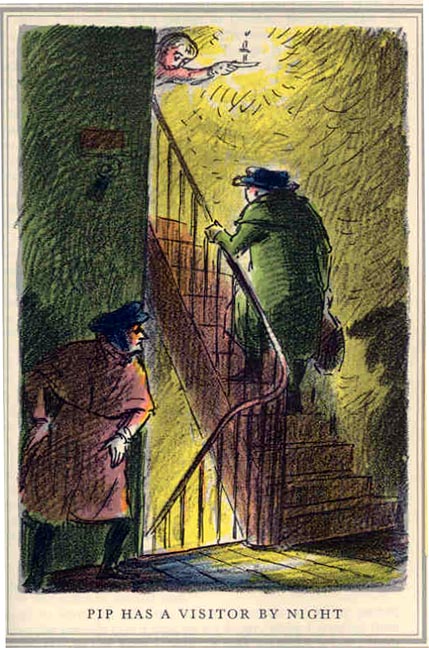Click on images for larger pictures.

In the thirty-ninth chapter of the Heritage Edition (1939) of Great Expectations, the twentieth-century British illustrator and World War II War Office artist Edward Ardizzone crosses the line between illustrating the text and substantially changing the reader's apprehension of the narrative. On page 301, with Herbert conveniently absent on business in France, Pip holds up his "light" (in the text, a reading lamp; in the chapter heading vignette, a candle) as a figure in a great coat and top hat ascends the stairs, his back towards us. Thus, the graphic artist has translated the first-person into a dramatic perspective, visualizing for the viewer-reader the action as if it is being enacted upon the stage. Although Dickens does not so specify, the artist has depicted Pip in a dressing gown in the 5.5 cm wide by 8 cm high pen-and-ink thumbnail sketch. The candle held aloft serves as an emblem of Pip's impending enlightenment about the source and nature of his "great expectations." So far, then, the pictorial text and the letter-press are consistent.

However, in the full-page watercolour illustration facing page 306 (one of just five such plates, measuring 11.8 cm wide by 17.4 cm high in a triple-ruled frame), Ardizzone prepares the reader for the fact that Magwitch is being followed. The spy, downstage right, is presumably either Compeyson himself or an agent of the novel's master-criminal. At this point in the narrative, neither Pip nor Magwitch mentions the possibility that the ex-convict is being followed, although in his brief recounting of his intention to leave Australia in order to see the gentleman he made Magwitch does note that "It warn't easy . . . for me to leave them parts, nor yet it warn't safe" (309), and that "caution is necessary" because he "should of a certainty be hanged if took" (309). The illustration's alerting the reader to Magwitch's already being under surveillance heightens the suspense as Ardizzone's reader-viewer ponders both the identity and the intentions of the mysterious figure so prominently positioned in the plate. The tense figure, surreptitiously regarding and overhearing the dialogue between the convict godfather and his adoptive son, is in an analogous position to the reader, perhaps learning for the first time that there is some sort of relationship between the two, unlikely as that connection may seem initially. The plate establishes in the reader's mind an anticipatory set largely unconnected to the text of the novel, for Dickens does not reveal that an unknown agent is tailing Magwitch until Ch. 40, when Pip learns from the watchman that the man upon whom he stumbled on the back stairs. The answers to the questions that the presence of the sinister watcher in Plate 43, "Pip has a visitor by night," raises in the reader's mind thrust him forward into the third stage of Pip's expectations in Ch. 40. Later, partly through Magwitch's narrative in Ch. 42 and partly through the misadventure in the sluice-house in Ch. 53, Dickens clarifies the identities of the sinister forces are endeavouring to ensnare Pip and Magwitch.
Clever as this gambit on the part of the illustrator may seem, it challenges the hegemony of the text, implying that the artist knows more (or is prepared to disclose more) than the narrator of the text. We note, moreover that, although the watchman indicates that the spy was wearing "a dark coat" (Ch. 40, p. 313), the artist has given him a lighter coat, probably to integrate the figure within the plate's limited colour scheme, the stairs being rendered in the same shaded red. Had Dickens been alive to vet his illustrator's productions, he would almost have certainly vetoed the intrusion of the clandestine "lurker on the stairs" (Ch. 40, p. 313). The novelist would have insisted upon the right to control the reader's responses and to use Pip exclusively as the vehicle for unfolding the secrets of the narrative. However, with the novelist safely out of the way, the modern illustrator may safely satisfy himself as to the handling of the visual complement in relation to its nineteenth-century letterpress.
Bibliography
Dickens, Charles. Great Expectations (1860-61). Illus. Edward Ardizzone. New York: Heritage Press, 1939.
Last modified 10 November 2005